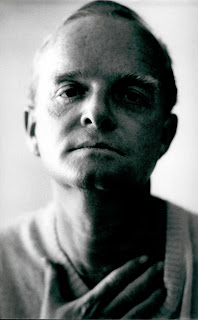*UPDATE. Cooper came out publicly July 1, 2012, in a casual, off-handed way by commenting on his sexual orientation in response to a friend's blog post. He now speaks openly about his sexual orientation.
His recent real estate project, however, can lead us to speculate that the silver fox might indulge in a fireman fantasy or two. Cooper purchased the historic Fire Patrol House No. 2, at 84 West Third Street (between Sullivan & Thompson in NYC's Greenwich Village) and then restored it for use as his personal residence. Removal of many coats of exterior paint revealed the original handsome brick, terra cotta and limestone architectural details. The garish red and white paint job on the face of the ground floor was replaced by a more somber black with original limestone accents. The man has taste, and apparently bucketloads of money.
But this was a Fire Patrol House, not a NYC fire department station. In the early 19th century, insurance companies hired citizens to walk about at night to watch out for fires, an idea first proposed by Benjamin Franklin. These Fire Patrol people would spot and extinguish fires, saving insurance underwriters significant payouts. Their fire wagons would deliver heavy tarps to cover broken windows and protect furniture and delicate equipment in order to minimize water damage from fire fighter’s efforts. Among the patrolmen’s duties were water removal and salvage work after a fire had been put out, providing the insurers with an on-site link to the extent of fire damage. Modern inventions such as telephones and electric streetlights made the Fire Patrol largely obsolete, but the tradition prevailed in some cities, with NYC being the last holdout. The city’s fire patrol was not disbanded until 2006.
Anderson Cooper moved into his fire house in January 2012, sharing the deluxe restored quarters with his partner, gay bar owner Benjamin Maisani* (above). Cooper's work crew removed the paint from the brick and stone detailing (above right), including the head of Mercury, which represents the speed at which the fire patrolmen respond to fires.
*UPDATE: In March 2018 Cooper (50 at the time) stated that he and Maisani "had separated as boyfriends some time ago", and that Cooper was seeing a 33-year-old doctor based in Dallas TX.
Built in 1906, Fire Patrol Station Number 2 had never been updated. When Cooper bought it, the structure still had the original wood flooring, windows, spiral staircase, fire poles and hand-sawn ceiling beams. Even the stables that once housed the patroller’s horses remained intact at the rear of the building.
That was the good news. Over time the fire patrolmen had exercised much-misplaced taste in "improving" the look of their home. The stone sculpture of Mercury above the double entry doors had been painted in flesh-colored enamel with bright yellow hair. The limestone at street level had been painted glossy white with bright "fire engine red" enamel covering the ground floor brickwork. The upper stories' brick, tile and stone façade had been painted over in a dull red. Mr. Cooper had his work cut out for him.
Until 1906 Fire Patrol Number 2 had operated at 31 Great Jones Street in Greenwich Village, but a boarding house at 84 West 3rd Street, one block south of Washington Square Park, was purchased and razed for the construction of a new red brick four-story patrol house.
The façade was embellished by limestone quoins with terra cotta accents, and a carved head of Mercury above the truck entrance signified the speed of the responders. When the fire patrollers moved into their new home in 1907, an elevated railroad covered 3rd Street directly in front of the building (see vintage photo).
During their hundred years at West Third Street, the men engaged in many acts of heroism, but a recent event brought renewed interest in the Fire Patrol system, which in modern times was involved mostly with salvage work at commercial fire sites. Among the emergency responders to the World Trade Center disaster on the morning of September 11, 2001, was 27-year-old fire patrolman Keith Roma. A member of Fire Patrol Number 2, he had worked for over an hour evacuating World Trade Center employees – eyewitnesses estimate that he personally removed more than 200 individuals. Roma himself, however, was never seen again after that day. On Christmas Eve, 2001, his body, with fire helmet at his side, was discovered alongside those of nine civilians he was trying to save. He was the first fire patrolman to die in the line of duty in more than three decades. A plaque outside Fire Patrol Number 2's building honors his sacrifice. Throughout their history, 32 patrolmen had died in the line of duty.
When NYC’s Fire Patrol was disbanded in 2006, the New York Board of Fire Underwriters offered the building for sale. The Greenwich Village Historic Society panicked, quickly requesting landmark status from the Landmarks Preservation Commission. Their fears were for naught, because Anderson Cooper hired architect Cary Tamarkin to preserve and renovate the fire patrol house into a private residence.
“We could not be happier with the gorgeous exterior renovation that highlights and respects the unique history of the building,” the Society said in its blog on September 1, 2011. Tamarkin restored the stone and terra cotta detailing, removed the layers of paint and replaced the windows with replicas. The architect retained interior details such as the herringbone brick floor, brass fire poles and cast iron spiral staircase. When Cooper moved in earlier this year, among the original features he retained was the old firemen’s gym, which he outfitted with old-fashioned bar bells and weights. It is a praiseworthy example of the reuse of vintage structures and a fitting testament to the history of the New York Fire Patrol, which had operated in the city from 1839 until 8:00 a.m. on October 15, 2006.









































